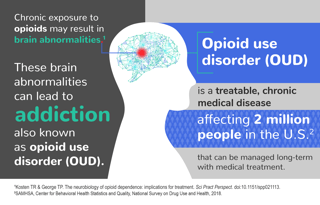
Opioid use disorder (OUD) is a substance use disorder characterized by cravings for opioids, continued use despite physical and/or psychological deterioration, increased tolerance with use, and withdrawal symptoms after discontinuing opioids. Opioid withdrawal symptoms include nausea, muscle aches, diarrhea, trouble sleeping, agitation, and a low mood. Addiction and dependence are important components of OUD. Risk factors for OUD include a history of opioid misuse, current opioid misuse, young age, socioeconomic status, race, untreated psychiatric disorders, and environments that promote misuse (social, family, professional, etc.). Complications may include opioid overdose, suicide, HIV/AIDS, hepatitis C, and problems meeting social or professional responsibilities. Diagnosis may be based on criteria by the American Psychiatric Association in the DSM-5. Opioids include substances such as heroin, morphine, fentanyl, codeine, dihydrocodeine, oxycodone, and hydrocodone. A useful standard for the relative strength of different opioids is morphine milligram equivalents (MME). It is recommended for clinicians to refer to daily MMEs when prescribing opioids to decrease the risk of misuse and adverse effects. opiates and opioids MME of common opioids Long-term opioid use occurs in about 4% of people following their use for trauma or surgery-related pain. In the United States, most heroin users begin by using prescription opioids that may also be bought illegally. People with an opioid use disorder are often treated with opioid replacement therapy using methadone or buprenorphine. Such treatment reduces the risk of death. Additionally, they may benefit from cognitive behavioral therapy, other forms of support from mental health professionals such as individual or group therapy, twelve-step programs, and other peer support programs. The medication naltrexone may also be useful to prevent relapse. Naloxone is useful for treating an opioid overdose and giving those at risk naloxone to take home is beneficial. In 2020, the CDC estimated that nearly 3 million people in the U.S. were living with OUD and more than 65,000 people died by opioid overdose, of whom more than 15,000 were heroin overdoses. Recent estimates of the number of people living with OUD and annual opioid overdoses worldwide are 16 million and 120,000, respectively. From Wikipedia
